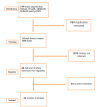A Scoping Review on the Prevalence and Determinants of Post-Traumatic Stress Disorder among Military Personnel and Firefighters: Implications for Public Policy and Practice
- PMID: 35162587
- PMCID: PMC8834704
- DOI: 10.3390/ijerph19031565
A Scoping Review on the Prevalence and Determinants of Post-Traumatic Stress Disorder among Military Personnel and Firefighters: Implications for Public Policy and Practice
Abstract
Introduction: Firefighters and military personnel are public safety personnel who protect the safety of individuals and their properties. They are usually exposed to traumatic events leaving them at risk of developing mental health conditions such as post-traumatic stress disorder (PTSD). Increasing concern is being raised regarding the mental health impacts, specifically PTSD, among military personnel and firefighters.
Objective: There is an increased exposure of firefighters and military personnel to traumatic events and the attendant risk of developing post-traumatic stress disorder. It is crucial to ascertain the level of PTSD amongst this cohort and determinants to formulate policies and practices that mitigate the risk and protect public safety personnel. This scoping review sought to determine the prevalence of PTSD among this cohort globally and to explore determinants of this mental health condition.
Methods: A literature search in databases including MEDLINE, CINAHL, PubMed, PsycINFO, and EMBASE was conducted electronically from May 2021 to 31 July 2021. Two reviewers independently assessed full-text articles according to the predefined inclusion criteria and screening process undertaken to identify studies for the review. Articles were screened with a third reviewer, resolving conflicts where necessary and further assessing them for eligibility. During article selection, the PRISMA checklist was adopted, and with the Covidence software, a total of 32 articles were selected for the final examination. For the eligible studies, data extraction was conducted, information was collated and summarized, and the findings were reported. Original qualitative and quantitative data on the prevalence and predictors of PTSD among veterans, military, and firefighters were reported.
Results: The prevalence of PTSD was 57% for firefighters and 37.8% for military personnel. Demographic factors, job factors, social support, injuries, physical and psychological factors, and individual traits were the main predictors of PTSD in this cohort.
Conclusion: This information is vital for developing and implementing prevention and intervention strategies for PTSD in military personnel and firefighters. Recognizing and addressing factors that predict PTSD will help to improve mental wellbeing and increase productivity. More peer-reviewed studies are needed on the prevalence of PTSD amongst these cohorts.
Keywords: PTSD; determinants; firefighters; military personnel; prevalence.
Conflict of interest statement
The authors declare no conflict of interest.
Figures
Similar articles
-
Deployment of personnel to military operations: impact on mental health and social functioning.Campbell Syst Rev. 2018 Jun 1;14(1):1-127. doi: 10.4073/csr.2018.6. eCollection 2018. Campbell Syst Rev. 2018. PMID: 37131363 Free PMC article.
-
A meta-analysis of risk factors for combat-related PTSD among military personnel and veterans.PLoS One. 2015 Mar 20;10(3):e0120270. doi: 10.1371/journal.pone.0120270. eCollection 2015. PLoS One. 2015. PMID: 25793582 Free PMC article.
-
Beyond the black stump: rapid reviews of health research issues affecting regional, rural and remote Australia.Med J Aust. 2020 Dec;213 Suppl 11:S3-S32.e1. doi: 10.5694/mja2.50881. Med J Aust. 2020. PMID: 33314144
-
A Scoping Review of Protective Factors That Contribute to Posttraumatic Wellbeing for Trauma-Exposed Military Service Members and Veterans.Trauma Violence Abuse. 2025 Apr;26(2):235-250. doi: 10.1177/15248380241309385. Trauma Violence Abuse. 2025. PMID: 40022625
-
Occupational therapy for military personnel and military veterans experiencing post-traumatic stress disorder: A scoping review.Aust Occup Ther J. 2020 Oct;67(5):479-497. doi: 10.1111/1440-1630.12684. Epub 2020 Jul 5. Aust Occup Ther J. 2020. PMID: 32627215
Cited by
-
The Role of Genetic Variations in the FAAH rs324420 Polymorphism and its Interaction with CRHR1 rs110402 and CNR1 rs2180619 in Anxiety and- Trauma Related Symptoms After Military Deployment.Chronic Stress (Thousand Oaks). 2024 Oct 7;8:24705470241285828. doi: 10.1177/24705470241285828. eCollection 2024 Jan-Dec. Chronic Stress (Thousand Oaks). 2024. PMID: 39484094 Free PMC article.
-
Knowledge, mechanisms, and intervention of the polytrauma clinical triad in military pain medicine.Korean J Pain. 2025 Jul 1;38(3):222-243. doi: 10.3344/kjp.24425. Korean J Pain. 2025. PMID: 40589056 Free PMC article. Review.
-
Association Between Social Support, and Depressive Symptoms Among Firefighters: The Mediating Role of Negative Coping.Saf Health Work. 2023 Dec;14(4):431-437. doi: 10.1016/j.shaw.2023.10.002. Epub 2023 Oct 5. Saf Health Work. 2023. PMID: 38187206 Free PMC article.
-
Treatment of Posttraumatic Stress Disorder: A State-of-the-art Review.Curr Neuropharmacol. 2024;22(4):557-635. doi: 10.2174/1570159X21666230428091433. Curr Neuropharmacol. 2024. PMID: 37132142 Free PMC article. Review.
-
Predictors of differential PTSD and depression symptom trajectories in firefighters: a growth mixture analysis.Eur J Psychotraumatol. 2025 Dec;16(1):2535898. doi: 10.1080/20008066.2025.2535898. Epub 2025 Aug 12. Eur J Psychotraumatol. 2025. PMID: 40792378 Free PMC article.
References
-
- Smith S.M., Goldstein R., Grant B.F. The association between post-traumatic stress disorder and lifetime DSM-5 psychiatric disorders among veterans: Data from the National Epidemiologic Survey on Alcohol and Related Conditions-III (NESARC-III) J. Psychiatr. Res. 2016;82:16–22. doi: 10.1016/j.jpsychires.2016.06.022. - DOI - PMC - PubMed
-
- Wilson S., Guliani H., Boichev G. On the economics of post-traumatic stress disorder among first responders in Canada. J. Community Saf. Well-Being. 2016;1:26–31. doi: 10.35502/jcswb.6. - DOI
-
- Marmar C.R., Schlenger W., Henn-Haase C., Qian M., Purchia E., Li M., Corry N., Williams C.S., Ho C.-L., Horesh D., et al. Course of Posttraumatic Stress Disorder 40 years after the Vietnam War: Findings from the National Vietnam Veterans Longitudinal Study. JAMA Psychiatry. 2015;72:875–881. doi: 10.1001/jamapsychiatry.2015.0803. - DOI - PubMed
-
- Mat-Salleh M.-N. Prevalence and predictors for Post-Traumatic Stress Disorder (PTSD) among firefighters: A systematic review. Int. J. Public Health Res. 2020;10:1183–1194.
Publication types
MeSH terms
LinkOut - more resources
Full Text Sources
Medical



